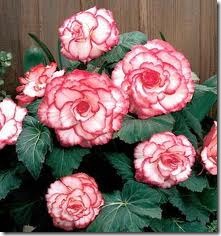Begonias are a favorite of many gardeners because of their bold and beautiful blooms. Once you learn how to properly grow begonias they require little care and are very hardy. The learning curve of cultivation is what usually stumps many gardeners in the beginning. A few common begonia diseases can creep up on you if you are not vigilant.
Prevention
-
Practicing good care of your begonias can cut down the likelihood of contracting some begonia diseases. Adequate spacing and ventilation is crucial for a healthy begonia, so plant them at least 9 inches from each other or other plants. Most begonias are succulent plants. This means that if they are too moist, they will rot and eventually die; water only when top soil is dry to the touch. Do not plant in direct sunlight; begonias enjoy partial shade.
Considerations
-
 This begonia leaf is free of disease.
This begonia leaf is free of disease.Dead leaves at the root does not make good compost for begonias. When any part of the plant naturally dies, like the leaves or flowers, remove them as soon as possible because that is what makes the some diseases like Botrytis develop in the first place.
Powdery Mildew
-
The appearance of powdery mildew is a fairly common begonia problem. It is easily spotted by the white or grayish dusting on the leaves; in fact, many people mistake it as dust. The first symptoms appear as white circular shapes on the leaves, stems or flowers, then spreads as a dusty coating. The mildew causes stunted growth and can be deadly to begonias if left untreated.
Fungicides or sulfur can be used to prevent or eliminate powdery mildew. If you do not like using chemicals on your begonia, consider using an non-pesticide spray that you make yourself by smashing four garlic cloves (garlic is high in sulfur and safe for your plant) in 4 to 5 oz. of water. Put the solution in a spray bottle and spray your begonia as soon as symptoms appear. Treatments can be given about once a week until symptoms subside.
Botrytis
-
 Leafy begonias add color to a space.
Leafy begonias add color to a space.Botrytis is known as brown rot or stem rot. Moist brown spots can appear on the stem, leaves or flowers. Your begonia will then start to develop an overall fuzzy, gray mold if left untreated and will eventually die.
The only intervention option is to completely remove the affected areas. You may have to cut back stems below the affected area, which will inhibit the season’s growth, but this step is necessary to save the plant.
Bacterial Leaf Spot Blight
-
Bacterial leaf spot is one of the most common and wide-spread diseases for begonias, according to the Department of Crop Sciences at the University of Illinois. It is usually caused by too much moisture. The condition can be spotted by wet brown spots and blisters on the leaves. As the blight continues, these spots will take on a yellow edging. If left untreated, the begonia will slowly lose leaves, turn mushy and die. The only solution is to cut off infected areas


Deprecated: strpos(): Passing null to parameter #1 ($haystack) of type string is deprecated in /home/agriviek8Qv/agriviet.net/public_html/wp-includes/comment-template.php on line 2522